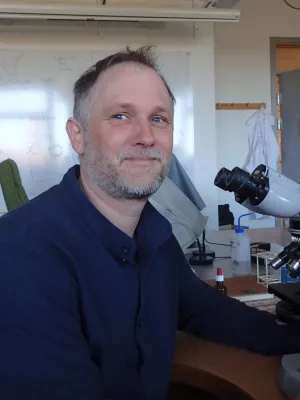
Karl Ljung
Lecturer

Palaeoenvironmental changes in eastern Crimea over the last 7600 years inferred from a multi-proxy study of a sediment archive from Lake Chokrak
Author
Summary, in English
The study presents a multi-proxy archive from hypersaline coastal Lake Chokrak in eastern Crimea, a steppe region which is particularly susceptible to moisture fluctuations. XRF, organic carbon and nitrogen, and palynological analyses are used to reconstruct the evolution of the lake and landscape development around it and to provide information about the driving forces behind those changes, such as climate and human impact. The findings show that the basin was an open marine bay between 7640 and 5500 cal. yr BP. After 5500 cal. yr BP, the low rates of sea-level rise led to gradual infilling of the basin. The prevalence of mesic herb-grass steppe around the site, as well as the expansion of broad-leaved trees in the Crimean mountains, indicate relatively warm and humid climate conditions during the Mid-Holocene. Elemental proxies and marine NPPs point to a transition to lagoonal conditions from 4270 cal. yr BP. The progressive shallowing of the basin was accompanied by the spread of more xeric Artemisia-grass steppe, which suggests a shift to arid conditions. The occurrence of cereal pollen from 3660 cal. yr BP may indicate the first signs of cultivation in the study area. The active build-up of a sand barrier from 3000 cal. yr BP led to a gradual separation of the basin from the sea. By 900 cal. yr BP, the fully-formed sand barrier resulted in a transformation of the lagoon into a hypersaline lake. The closing of the lagoon was accompanied by an expansion of halophytic communities around the site. Human-induced vegetation changes became more pronounced with the development of agrarian and pastoral activities around the site from ca. 750 cal. yr BP.
Department/s
- Department of Geology
- Quaternary Sciences
- Environmental Science
- BECC: Biodiversity and Ecosystem services in a Changing Climate
Publishing year
2024-02
Language
English
Pages
175-188
Publication/Series
Holocene
Volume
34
Issue
2
Document type
Journal article
Publisher
SAGE Publications
Topic
- Geology
Keywords
- coastal processes
- Holocene
- human impact
- hypersaline lake
- organic geochemistry
- palaeoclimate
- palynology
- vegetation history
- XRF
Status
Published
ISBN/ISSN/Other
- ISSN: 0959-6836

